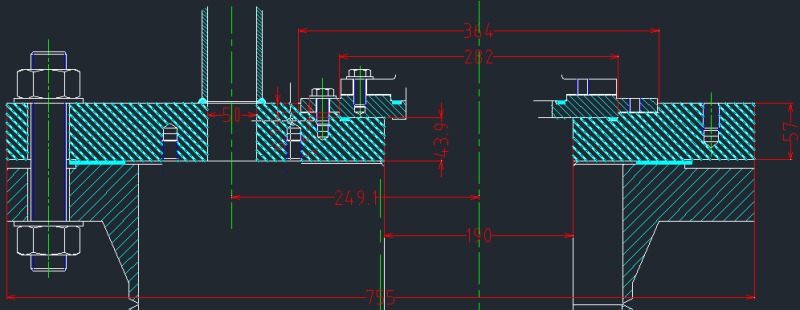Hello there !
I need to design a flat head with multiple openings according to ASME VIII Div 1 and more particularly UG-36 and UG-39.
First of all, I determine the minimum required thickness of the flat head without opening using UG-34. Then I tried to calculate the openings.
I have 4 openings in the flat head (see attachements)
Do the openings need a reinforcement as per UG-36(c)(3)(-a)(-2) ?
Opening 1,2,3 respects the rules of UG-36(c)(3)(-a)(-2) --> these openings don't need reinforcement
Opening 4 : there are multiple diameters for this opening. So I calculated an equivalent diameter using Appendix 13-6 --> this opening need a reinforcement.
Do the position of the openings satisfy the rules of UG-36(c)(3)(-d) ?
Opening 2 and 3 : the distance between the two openings doesn't respect the rules of UG-36(c)(3)(-d) --> they can't stay unreinforced
Opening 3 and 1 : the distance between the two openings doesn't respect the rules of UG-36(c)(3)(-d) --> they can't stay unreinforced
Opening 1 and 2 : the distance between the two openings respects the rules of UG-36(c)(3)(-d) --> they can stay unreinforced
Conclusion : if I make a calculation of reinforcement for opening 3, openings 1 and 2 can stay unreinforced.
Reinforcement of openings 3 and 4
Below, there is a view of openings 3 and 4 that need to be reinforced.
From here, I don't consider opening 1 and 2 anymore as specified in UG-39(a).
UG-38(b) : the two openings diameters (equivalent diameter for opening 4) are less than one half of the diameter of the head
UG-38(b)(1) : my flat head have two openings --> not applicable
UG-38(b)(2) : the two openings diameters (equivalent diameter for opening 4) are less than one half of the diameter of the head and the average diameter of this pair is less than one-quarter of the head diameter. But the spacing is less than twice the average diameter but greater than 1.25 the average diameter. So I need to determine to area of reinforcement for each opening, sum them up abd distribute the area such that 50% of the sum is located between the two openings.
My questions
1 - Is it the good way to analyse this problem ?
2 - How do I calculate the reinforcement of the big opening as there is no nozzle welded on it but a flat head with another opening bolted on it ? Should I considered the other flat head as a welded nozzle ?
3 - UG-39(d)(2) indicates that I can also increase the head thickness instead of calculating the reinforcement area. Is it correct ?
Thanks in advance guys,
Best regards,

I need to design a flat head with multiple openings according to ASME VIII Div 1 and more particularly UG-36 and UG-39.
First of all, I determine the minimum required thickness of the flat head without opening using UG-34. Then I tried to calculate the openings.
I have 4 openings in the flat head (see attachements)
Do the openings need a reinforcement as per UG-36(c)(3)(-a)(-2) ?
Opening 1,2,3 respects the rules of UG-36(c)(3)(-a)(-2) --> these openings don't need reinforcement
Opening 4 : there are multiple diameters for this opening. So I calculated an equivalent diameter using Appendix 13-6 --> this opening need a reinforcement.
Do the position of the openings satisfy the rules of UG-36(c)(3)(-d) ?
Opening 2 and 3 : the distance between the two openings doesn't respect the rules of UG-36(c)(3)(-d) --> they can't stay unreinforced
Opening 3 and 1 : the distance between the two openings doesn't respect the rules of UG-36(c)(3)(-d) --> they can't stay unreinforced
Opening 1 and 2 : the distance between the two openings respects the rules of UG-36(c)(3)(-d) --> they can stay unreinforced
Conclusion : if I make a calculation of reinforcement for opening 3, openings 1 and 2 can stay unreinforced.
Reinforcement of openings 3 and 4
Below, there is a view of openings 3 and 4 that need to be reinforced.
From here, I don't consider opening 1 and 2 anymore as specified in UG-39(a).
UG-38(b) : the two openings diameters (equivalent diameter for opening 4) are less than one half of the diameter of the head
UG-38(b)(1) : my flat head have two openings --> not applicable
UG-38(b)(2) : the two openings diameters (equivalent diameter for opening 4) are less than one half of the diameter of the head and the average diameter of this pair is less than one-quarter of the head diameter. But the spacing is less than twice the average diameter but greater than 1.25 the average diameter. So I need to determine to area of reinforcement for each opening, sum them up abd distribute the area such that 50% of the sum is located between the two openings.
My questions
1 - Is it the good way to analyse this problem ?
2 - How do I calculate the reinforcement of the big opening as there is no nozzle welded on it but a flat head with another opening bolted on it ? Should I considered the other flat head as a welded nozzle ?
3 - UG-39(d)(2) indicates that I can also increase the head thickness instead of calculating the reinforcement area. Is it correct ?
Thanks in advance guys,
Best regards,

